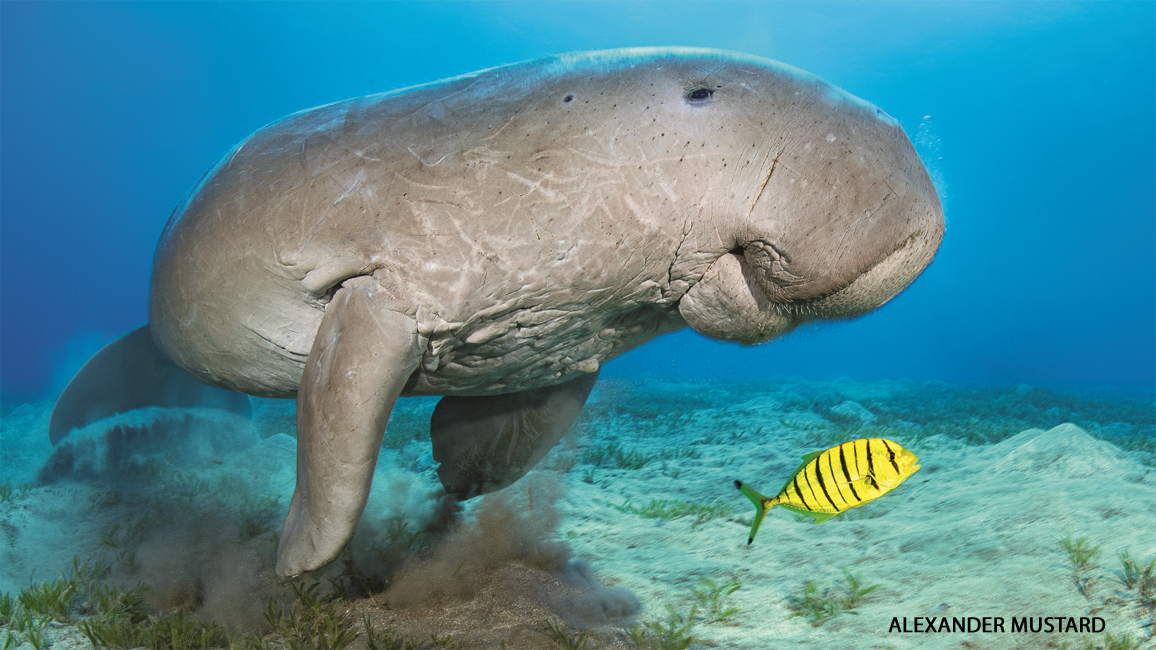
Dugongs
By Kathy KrankingThis poor guy suffers from a case of mistaken identity.

Lots of people would look at this animal and think it’s a manatee. Maybe you did, too. But this manatee lookalike is actually a dugong.
There’s a reason that dugongs look a lot like manatees: The two are cousins! But dugongs live in the Pacific and Indian oceans (see map), nowhere near any manatees. Keep reading to find out what makes a dugong a dugong . . . and not a manatee!

WHO’S WHO?
The easiest way to identify a dugong is to look at its tail. A manatee has a rounded tail, while a dugong’s tail looks like a whale’s. Another easy-to-see difference is that a manatee has nails on its flippers and a dugong doesn’t.
CHOW TIME
Unlike manatees, which can live in both the salty ocean and in freshwater rivers, dugongs stay in shallow areas of the ocean. They swim along, grazing in seagrass “meadows” on the ocean bottom. That’s why they are often called “sea cows.”
Dugongs eat seagrass for breakfast, lunch, dinner, and even midnight snacks! Using sensitive bristles on their lips to find food, they can gobble up to 80 pounds a day. A dugong’s snout faces downward to help it dig up seagrass as it moves along. And its teeth are flat and peg-like, good for crushing food against hard plates inside the dugong’s mouth.
When a dugong swims along looking for food, it often has company: small, hungry fishes. As the dugong snuffles through the sand pulling out seagrass, the little fishes feed on tiny creatures that are stirred up.

TAKE A BREATH
Dugongs are mammals, which means that they have to come up to the surface every few minutes to breathe air. The longest they can stay underwater is 12 minutes. While they’re under, they’re able to shut their nostrils to keep water out. Dugongs may swim alone or in small groups, but sometimes they’ll gather in herds of hundreds. They “talk” to each other using sounds such as chirps, whistles, or barks.
BIG BABY
A dugong mom usually gives birth to one calf at a time. A newborn calf is about as long as you are tall! It feeds on milk from a nipple behind each of its mom’s flippers. The baby usually stays pretty close to its mom, sometimes even riding on her back!
BAD NEWS
Dugongs don’t have many predators, though they sometimes may be attacked by large sharks, crocodiles, or killer whales. Humans are a far bigger threat. For thousands of years, people hunted dugongs for their meat and other parts. Hunting dugongs is now illegal in places where they are threatened, but some hunting still happens. Much worse, people are damaging dugongs’ seagrass habitat by building along the coasts and polluting the coastal waters. Dugongs can accidentally get caught in fishing nets or be hit by boats. All these things have caused their numbers to go down in most areas.
But people are working to help dugongs. They’ve banned fishing nets in some areas, and they’re trying to teach boaters to go slowly in places where dugongs live. Most importantly, they’re trying to save seagrass meadows that dugongs need to survive.
With a little luck and a lot of help, dugongs will keep swimming and munching their way through life.
















